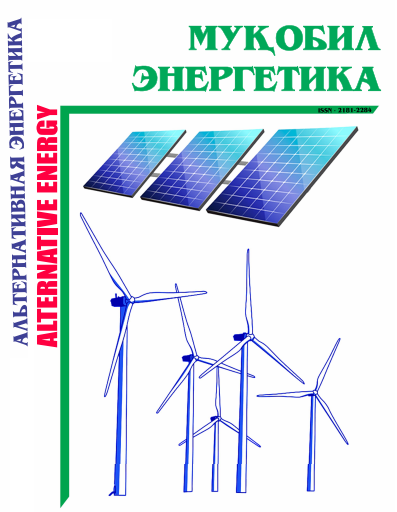RESEARCH OF THE KINETICS OF THE PYROLYSIS PROCESS OF BIOMASS (SUNFLOWER WASTE)
Keywords:
kinetics of pyrolysis, pyrolysis of biomass, sunflower waste, Comsol multiphysics, degradation, Kissinger method.Abstract
Abstract. Introduction. This article studies the kinetics of the pyrolysis process of biomass of sunflower waste particles based on Comsol multiphysics software, which allows us to determine the rate of chemical reactions occurring during the decomposition of the material and identify the main factors affecting the speed and efficiency of pyrolysis. The resulting models describe temperature trends quite well. It was concluded that the pyrolysis process of biomass of sunflower waste particles occurred in the temperature range of 440-717 K. At a temperature of 440 K, the biomass began to lose mass, and the mass loss stopped at a temperature of 717 K. The kinetic parameters were calculated using the Kissinger method. The least squares method and correlation analysis were used to calculate kinetic and constant parameters. The results will be useful in the future to optimize the process and conditions of the biomass pyrolysis process.
Methods and materials. For the analysis in this study, the biomass of sunflower waste was used, since this biomass has high thermal abilities and a high yield of bio-oil. The particle size was 0.02 m2, and the thermophysical properties of sunflower were used. The analysis was performed using Comsol Multiphysics software.
Results. When modeling the pyrolysis process of sunflower waste biomass based on Comsol Multiphysics software, temperature sensors were installed on the surface of the biomass and in the center of the biomass to measure temperature changes. Data on temperature changes depending on time are obtained. The models obtained describe temperature trends quite well, especially the temperature in the center of the biomass.
Conclusion. The kinetic parameters were calculated using the Kissinger method. The least squares method and correlation analysis were used to calculate kinetic and constant parameters. The results will be useful in the future to optimize the process conditions of the biomass pyrolysis process. In the Kissinger method, the kinetic parameters were the same for the entire pyrolysis process. The correlation coefficient between temperature and heating rate in the model is 0.86.
Downloads
References
[1] Jaroenkhasemmeesuk C., Tippayawong N., Thermal degradation kinetics of sawdust at intermediate heating rates, Appl. Therm. Eng., 103 (2016), pp. 170-176.
[2] Uzakov G., Mamatkulova S., Ergashev, S.: Thermal mode of the condenser of a pyrolysis bioenergy plant with recuperation of secondary thermal energy. E3S Web of Conferences, 411, 01021, (2023).
[3] Haykiri-Acma, H.,Yaman, S. and Kucukbayrak, S., “Effect of heating rate on the pyrolysis yields of rapeseed”, Renewable Energy, Vol. 31, (2006), 803-810. http://dx.doi.org/10.1016/j.renene.2005.03.013
[4] Islam, M.A., Auta, M., Kabir, G. and Hameed, B.H., “A thermogravimetric analysis of the combustion kinetics of karanja (Pongamiapinnata) fruit hulls char”, Bioresource Technology, Vol. 200, (2016), 335-341. (http://dx.doi.org/10.1016/j.biortech.2015.09.057).
[5] Uzakov G., Mamatkulova S., Ergashev Sh. and el. Modeling of heat exchange processes in a condenser of a pyrolysis bioenergy plant. BIO Web Conf., 71 02021. DOI: https://doi.org/10.1051/bioconf/20237102021, (2023).
[6] Mishra, G., Kumar, J. and Bhaskar, T., “Kinetic studies on the pyrolysis of pinewood”, Bioresource Technology, Vol. 182, (2015), 282-288. (http://dx.doi.org/10.1016/j.biortech.2015.01.087).
[7] Mamatkulova S. G. and Uzakov G. N.: Modeling and calculation of the thermal balance of a pyrolysis plant for the production of alternative fuels from biomass. IOP Conference Series: Earth and Environmental Science Т 1070 1, (2022).
[8] Damartzis, Th., Vamvuka, D., Sfakiotakis, S. and Zabaniotou, A., “Thermal degradation studies and kinetic modeling of cardoon (Cynaracardunculus) pyrolysis using thermogravimetric analysis (TGA)”, Bioresource Technology, Vol. 102, (2011), 6230-6238. http://dx.doi.org/10.1016/j.biortech.2011.02.060
[9] Zhai, M., Li, G., Zhang, Y., Dong, P., Qi, G. and Huang, Y., “Kinetic parameters of biomass pyrolysis by TGA”, Bio Resources, Vol. 4, (2016), 8548-8557. (http://dx.doi.org/10.15376/biores.11.4.8548-8557).
[10] Kaczor Z., Buliński Z., Werle S.: Modelling approaches to waste biomass pyrolysis: a review, Renewable Energy, 2020, Volume 159, Pages 427-443, ISSN 0960-1481, https://doi.org/10.1016/j.renene.2020.05.110.
[11] Mamatkulova S. Comsol multiphysics yordamida oʻsimlik biomassasining piroliz jarayonini modellashtirish. Innovatsion texnologiyalar 3(52), 2023.
[12] Singh S, Sawarkar AN. Thermal decomposition aspects and kinetics of pyrolysis of garlic stalk. Energy Sources, Part A:Recovery. Utilization, and Environmental Effects 2020. https://doi.org/10.1080/15567036.2020.1716891
[13] Singh P, Singh R.K., Gokul P.V., Hasan S.H., Sawarkar A.N. Thermal degradation and pyrolysis kinetics of two Indian rice husk varieties using thermogravimetric analysis. Energy Sources, Part A: recovery, Utilization, and Environmental Effects; 2020.
https://doi.org/10.1080/15567036.2020.1736215
[14] Heydari, M., Rahman, M. and Gupta, R., “Kinetic study and thermal decomposition behavior of lignite coal”, International Journal of Chemical Engineering, Vol. 2015, (2015), 1-9. (http://dx.doi.org/10.1155/2015/481739).






